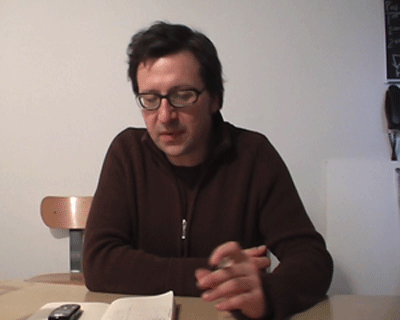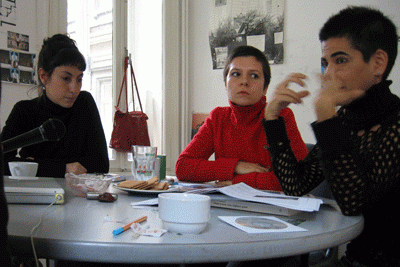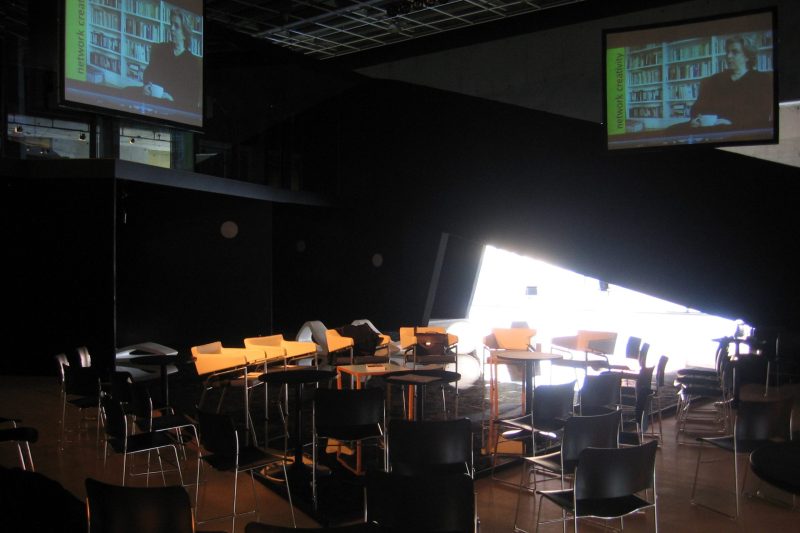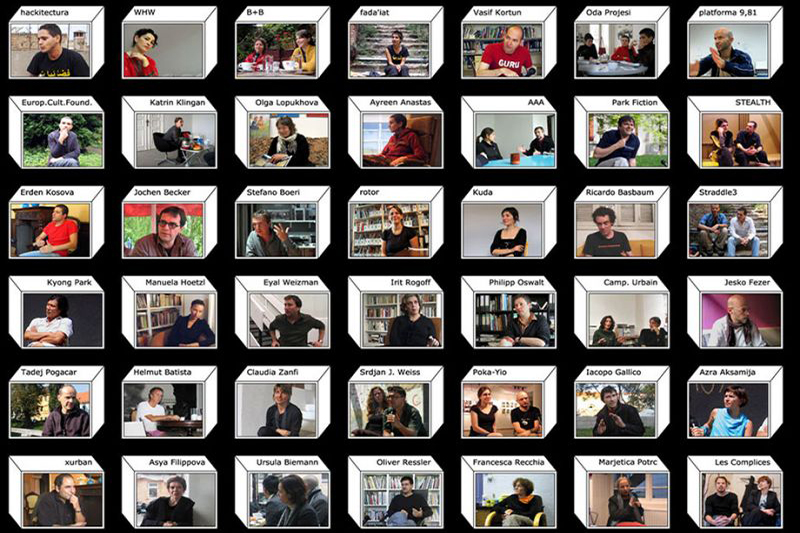- Interview
- New York
- 2007
- NETWORKED CULTURES
CONVERSATION WITH SRDJAN J. WEISS
PM/HM: To engage with different spatial challenges you have developed a system of different formats that are at the base of your work. What are the underlying ambitions of such an approach?
Srdjan Jovanovic Weiss: The issue is that I think I am trying to develop a complex system at start rather than simply complicate a system given apriori and in that sense the complexity is explored further together with the work itself. So it is an issue of learning with complexity, which makes its own openings and at the same time there are more openings than limitations. For instance my major collaborative exchange is with the Normal Architecture Office, NAO, which is a spatial practice attempt to propose space, design, expression, curating. It is a kind of practice experienced on an every day basis rehearsal of skills, that you can bring to any project in terms of scale, but it is architectural, it can be designed-related and it can be, let’s say, art representation-related. By exchanging some of expectations from architecture and art NAO can then subvert those fields, gain a bit of freedom within each project. For example in 2007, we collaborated with Yona Friedman for an exhibition at the Drawing Centre in New York which involved all three directions in NAO: urbanism, art curating and architectural installation. The idea to collaborate came from our meeting with Friedman in his apartment studio in Paris which in itself is arranged as a complex, but loose set of objects and pictures which he lives with.
The second collaboration is with the School of Missing Studies. If NAO is a collaboration based on proposals, SMS is a research platform for cities marked by abrupt transition. School of Missing Studies is not an alternative school in the traditional sense. I think the idea of having an alternative school is immediately cut in its roots of actually having a significance, to be taken seriously. So, School of Missing Studies involves a number of people in its core, architects, artists and curators who felt their own cities are abruptly converted and participants in the loose network. First research projects took place “at home”: Belgrade, New York, Rotterdam and the members of the group were invited to work with other cities like Munich, Halle, Moscow. Participants are diverse and often distinct and thus the range of topics start from any that can generate missing knowledge on abrupt cities to the actions that can be organised and networked. So, SMS is a place where I can be free to self-organise, engage different actors from the loose network of friends, new practitioners and also others. Now, the third collaboration is a test if some of NAO and SMS methods can be reflected in the sphere of high professionalism and architecture. I have collaborated with Herzog & de Meuron Architects from Basel, Switzerland on such a platform. H&deM started as a collaborative studio between architecture and art, take Remy Zaug or Thomas Ruff for example, and has today developed into a tight design company. My initial discussions with Jacques Herzog and Pierre de Meuron were about the curious necessity in the large office: how to be more efficient in terms of developing and grasping knowledge rather than emitting it all the time in form of design? The idea was, that if we can maintain the standard of not just making projects but also making concepts and points, then we may have that high professionalism considered conceptual and not only necessary. H&deM is currently collaborating with AMO on a study for the future of Haus der Kunst in Munich, a Nazi building from 1937 today showing high art. Departing from Jacques Herzog’s question “are buildings that were once abused for ideological or commercial purposes forever tainted, or are buildings stronger than ideologies?” we clearly are in front of a problem: node (building) versus network (ideology). And so, these three collaborations together basically form what I can tell I am doing.
PM/HM: What does it mean to work with a format like the School of Missing Studies on the Western Balkans as you did on the occasion of Lost Highway Expedition?
Srdjan Jovanovic Weiss: The format of School of Missing Studies is not an alternative university. It does not want to emulate or make a master class, or try to be replacement for a traditional school. It is not in the condition to be an alternative university like for example the Prishtina university was during the Kosovo crisis. The School of Missing Studies always had a chance to expand and shrink its participants beyond the core members without engaging the core member themselves. The big difference between Normal Architecture Office and School of Missing Studies in the method is that NAO meets and solves issues as a spatial practice. School of Missing Studies is more anarchic in a sense that it does not have meetings and the idea is to actually use that opportunity to self-organise for an actual action. The biggest action so far for SMS was the Lost Highway Expedition which had 350 participants in total and it was not meant to be a caravan, but a self-organised expedition with timelines of moving in and moving out at any possible moment. The genesis of the Lost Highway Expedition project, and its network of collaborators, came again from an idea coming from a network member in Skopje, Macedonia during another SMS project held in Belgrade. This idea was further discussed and developed into a project by all current SMS members. The intention was to break the idea of the identity capsule which all cities in the Western Balkans are in at the moment into a network, information highway. The idea is that one can see culturally what is going on and you can without calling yourself a network be able to relate knowledge about these post-socialist cities connected by infrastructure built during the socialist system. The very nature of relation that you can call collaboration had not been defined apriori, but left to emerge and become distinct during a period of discussions with a loose network of partners. Thus each city was seen through a distinct aspect, all together forming a web of topics that could even be seen in a single city. The thresholds had not been defined before they were actually crossed. If you think of an exhibition in the historic context, whoever is first somewhere is the one who upholds the project, but I think that today it is not about being first but really about not having that as an issue at all. This is very important because the idea of being first enhances the danger of restricting nostalgia, of not releasing nostalgia as a force on its own. For the Lost Highway Expedition it was extremely important that dynamic relationships between participants and disciplines are at the same time the form of researching knowledge. If you travel or if you are on an expedition it kind of makes you different from going from A to B on a specific task, but experience the expedition as a source of knowledge and not only as a source of prescribed direction.
To be able to release this potential SMS had to radically expand the field of action and get even looser. Originally invited by SMS to give a lecture in Belgrade Kyong Park, who is an established spatial practitioner, became one of the key figures in the Lost Highway Expedition. As well as Marjetica Potrc, who is as well a very established artist coming from the architectural education. And as well as Azra Akšamija, a young artist-architect. There are also highly active participants from the Lost Highway Expedition who became key figures in the process. For this to work as a non-hierarchical network we still needed to form a new organisation registered as Centrala Foundation for Future Cities as a producer of the expedition. It was also extremely interesting to observe how the approaches to knowledge creation and its exchangeability have been different between all the key figures from SMS and Centrala. For instance, Kyong Park would have one idea about it that comes from his experience about a loose organisation which then acquires a very strict casting and leadership. My idea was that we can have loose casting of characters but a strong network organisation. Practicing that and other inversions of established methods was extremely important because we have learned so much to recreate any temporal organisation to specific actors which fulfil it or make it be.
PM/HM: If a research operation is characterised by such instabilities, how can one create knowledge that feeds back to this array of different matters?
Srdjan Jovanovic Weiss: It makes it a polyphonic strategy. But at the same time it empties out itself from the need to become the bureaucratic exchange of expertise, which in traditional institutions is becoming the exchange of authority. So the authority I think is never really getting a chance to develop and everyone in this process is vulnerable, or let’s say all are encouraged to be vulnerable. The feedback is generated out of this kind of vulnerability as a dialog. It is interesting that vulnerability and feedback resonate in multiple fields from Lost Highway Expedition as a loose network to tight and immense organisations dealing with space such as Herzog & de Meuron. What would it actually really mean to establish a research cell in a highly efficient and world famous office of architecture in relation to vulnerability? It may prove it impossible.
The degree of vulnerability of any such spatial practice seems to define the sort of feedback one can expect to be surprised with. Trying to learn with the information that comes in in every single node, every single city is a case in difficulty, but also its potential. It may help learning to go beyond certain issues of metaphors, that have been definitely imposed over Western Balkan territory, Balkanisation is one of them. It has been used as a metaphor for many kinds of conflicts that involves disintegration of more than two entities. So in fact we have a kind of a metaphor floating around as a technology of interpretation without an actual content beyond the metaphor. Between Ljubljana, Zagreb, Novi Sad, Prishtina and so on the metaphor prevents the constellation of places. You don’t have a constellation of actual knowledge that can go with the technology of interpretation and influence it. The projects like Lost Highway Expedition can ‘see,’ where this content can come together and then be branched off into strategies of architecture, strategies of curating or artmaking. The branching off here is seen as a practice of positive balkanisation. With it we can understand or deliberately misunderstand certain misusages of the process of fragmentation which have been wishful thinking in different places like European Union or the Americas. If there is anything like geopolitics today, this kind of collective and non-utopian action is a micro-thing, a collective project based on the potential of personal loose networks.

Srdjan Jovanovic Weiss
is an architect and founder of Normal Architecture Office (NAO) as well as a founding member of School of Missing Studies. He is currently a lecturer at the University of Pennsylvania in Philadelphia and is pursuing his PhD at Goldsmiths, University of London. In 2006-07 Jovanovic Weiss collaborated with Herzog & de Meuron architects on research and design projects. His book Almost Architecture, published by Merz&Solitude and kuda.nao in 2006, explores the roles of architecture vis-à-vis democratic processes. His Lost Highway Expedition Photobook, co-edited with Katherine Carl was released in 2007.


